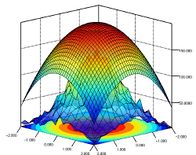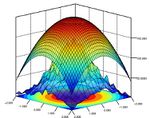|
|
| (3 intermediate revisions by 2 users not shown) |
| Line 4: |
Line 4: |
| |field_name=Computation and Visualization Environment | | |field_name=Computation and Visualization Environment |
| |field_developers=DataMelt community. Led by S.Chekanov | | |field_developers=DataMelt community. Led by S.Chekanov |
| |field_website=http://jwork.org/dmelt/ | | |field_website=https://datamelt.org/ |
| |field_data_tool_type=Application software | | |field_data_tool_type=Application software |
| |field_license_type=Free&Open source | | |field_license_type=Free&Open source |
| |field_free_software_licence=GPL / GNU for non commercial use. Commercial-friendly license is available | | |field_free_software_licence=GPL / GNU for non commercial use. Commercial-friendly license is available |
| |field_last_release=2018/05/10 | | |field_last_release=2019/02/02 |
| |field_last_version=2.2 | | |field_last_version=2.4 |
| |field_description='''DataMelt is a software environment for numeric calculations, statistics and data analysis ''' | | |field_description='''DataMelt is a software environment for numeric calculations, statistics and data analysis ''' |
|
| |
|
| Line 44: |
Line 44: |
|
| |
|
| ==Documentation== | | ==Documentation== |
| In 2018, DataMelt web contained about 600 examples written in Jython, Java, Groovy, JRuby, covering a number of fields, from general mathematics to data mining and data visualization. The Java API documentation includes the description of more than 40,000 Java classes. The DataMelt documentation includes certain restrictions for general public due to the proprietorial nature of the documentation project. | | |
| | In 2018, DataMelt web page hosted about 600 examples written in Jython, Java, Groovy, JRuby, covering a number of fields, from general mathematics to data mining and data visualization. The Java API documentation includes the description of more than 40,000 Java classes. The DataMelt documentation includes certain restrictions for general public due to the proprietorial nature of the documentation project. |
|
| |
|
|
| |
|
| Line 66: |
Line 67: |
| <ref>Big Data - A Survey of Big Data Technologies. By P.Dhavalchandra, M.Jignasu, R.Amit. International Journal of Science and Technology. Volume 2, p45-50 (2016) [http://www.ijsrt.us/vol2issue1/pdf%209.pdf] | | <ref>Big Data - A Survey of Big Data Technologies. By P.Dhavalchandra, M.Jignasu, R.Amit. International Journal of Science and Technology. Volume 2, p45-50 (2016) [http://www.ijsrt.us/vol2issue1/pdf%209.pdf] |
| </ref> | | </ref> |
| | | . |
| ==Usage==
| |
| | |
| DataMelt is a part of the software library of National Institutes of Health Library
| |
| <ref>Data Sciences Workstation: SCaVis. By Lisa Federer. National Institutes of Health Library [http://nihlibrary.campusguides.com/c.php?g=102650&p=672758]</ref>,
| |
| Mathematical support of Institute for Nuclear Research of Russian academy of Sciences<ref>The DataForge, Sector for Mathematical Support of Institute for Nuclear Research of Russian academy of Sciences [http://www.inr.ru/~nozik/dataforge/misc.html]</ref> and others.
| |
| On a commercial site, DataMelt is provided as a service on Amazon EC2 clouds
| |
| by the Miri Infotech IT Solution Provider company<ref>Miri Infotech. A Complete IT Solution Provider. [http://www.miritech.com/products/aws/datamelt.aspx DataMelt deployment]</ref>.
| |
Computation and Visualization Environment 2.4 (2019/02/02)
Developed by: DataMelt community. Led by S.Chekanov
License: GPL / GNU for non commercial use. Commercial-friendly license is available
Web page : Tool homepage
Tool type : Application software
The last edition of this page was on: 2018/05/23
The Completion level of this page is : Medium
The last edition of this page was on: 2018/05/23 The Completion level of this page is : Medium
SHORT DESCRIPTION
DataMelt is a software environment for numeric calculations, statistics and data analysis
DataMelt, or DMelt, is an environment for numeric computation, data analysis and data visualization. DMelt is designed for analysis of large data volumes ("big data"), data mining, statistical analyses and math computations. The program can be used in many areas, such as natural sciences, engineering, modeling and analysis of financial markets.
DMelt is a computational platform: It can be used with different programming languages on different operating systems. Unlike other statistical programs, DataMelt is not limited by a single programming language. Data analysis and statistical computations can be done using high-level scripting languages (Python/Jython, Groovy, etc.), as well as a lower-level language, such as JAVA. It incorporates many open-source JAVA packages into a coherent interface using the concept of dynamic scripting.
DMelt creates high-quality vector-graphics images (SVG, EPS, PDF etc.) that can be included in LaTeX and other text-processing systems.
The program runs on Windows, Linux, Mac OS.
TOOL CHARACTERISTICS
Usability
Authors of this page consider that this tool is rather easy to use.
Tool orientation
This tool is designed for general purpose analysis.
Data mining type
This tool is made for '.
Manipulation type
This tool is designed for Data transformation, Data analysis, Data visualisation.
| Tool objective(s) in the field of Learning Sciences |
|
☑ Analysis & Visualisation of data
☑ Predicting student performance
☑ Student modelling
☑ Social Network Analysis (SNA)
☑ Constructing courseware
|
☑ Providing feedback for supporting instructors:
☑ Recommendations for students
☑ Grouping students:
☑ Developing concept maps:
☑ Planning/scheduling/monitoring
☑ Experimentation/observation
|
Tool can perform:
- Data extraction of type:
- Transformation of type: Mathematical transformation of data for analysis
- Data analysis of type: Basic statistics and data summarization, Data mining methods and algorithms
- Data visualisation of type: Sequential Graphic, Chart/Diagram, Map (These visualisations can be interactive and updated in "real time")
ABOUT USERS
Tool is suitable for:
Students/Learners/Consumers
Teachers/Tutors/Managers
Researchers
Developers/Designers
Organisations/Institutions/Firms
Others
Required skills:
SYSTEM ADMINISTRATION: None
DATA MINING MODELS: Medium
FREE TEXT
Tool version : Computation and Visualization Environment 2.4 2019/02/02
(blank line)
Developed by : DataMelt community. Led by S.Chekanov
(blank line)
Tool Web page : https://datamelt.org/
(blank line)
Tool type : Application software
(blank line)
License:GPL / GNU for non commercial use. Commercial-friendly license is available
| 
|
SHORT DESCRIPTION
DataMelt is a software environment for numeric calculations, statistics and data analysis
DataMelt, or DMelt, is an environment for numeric computation, data analysis and data visualization. DMelt is designed for analysis of large data volumes ("big data"), data mining, statistical analyses and math computations. The program can be used in many areas, such as natural sciences, engineering, modeling and analysis of financial markets.
DMelt is a computational platform: It can be used with different programming languages on different operating systems. Unlike other statistical programs, DataMelt is not limited by a single programming language. Data analysis and statistical computations can be done using high-level scripting languages (Python/Jython, Groovy, etc.), as well as a lower-level language, such as JAVA. It incorporates many open-source JAVA packages into a coherent interface using the concept of dynamic scripting.
DMelt creates high-quality vector-graphics images (SVG, EPS, PDF etc.) that can be included in LaTeX and other text-processing systems.
The program runs on Windows, Linux, Mac OS.
TOOL CHARACTERISTICS
| Tool orientation |
Data mining type |
Usability |
| This tool is designed for general purpose analysis. |
This tool is designed for . |
Authors of this page consider that this tool is rather easy to use. |
| Data import format |
Data export format |
| . |
. |
| Tool objective(s) in the field of Learning Sciences |
|
☑ Analysis & Visualisation of data
☑ Predicting student performance
☑ Student modelling
☑ Social Network Analysis (SNA)
☑ Constructing courseware
|
☑ Providing feedback for supporting instructors:
☑ Recommendations for students
☑ Grouping students:
☑ Developing concept maps:
☑ Planning/scheduling/monitoring
☑ Experimentation/observation
|
Can perform data extraction of type:
Can perform data transformation of type:
Mathematical transformation of data for analysis
Can perform data analysis of type:
Basic statistics and data summarization, Data mining methods and algorithms
Can perform data visualisation of type:
Sequential Graphic, Chart/Diagram, Map (These visualisations can be interactive and updated in "real time")
ABOUT USER
| Tool is suitable for: |
| Students/Learners/Consumers:☑ |
Teachers/Tutors/Managers:☑ |
Researchers:☑ |
Organisations/Institutions/Firms:☑ |
Others:☑ |
| Required skills: |
| Statistics: ADVANCED |
Programming: BASIC |
System administration: NONE |
Data mining models: MEDIUM |
OTHER TOOL INFORMATION

|
| Datamelt 2dhisto.jpeg
|
| Dm logo125px.png
|
| Computation and Visualization Environment
|
| GPL / GNU for non commercial use. Commercial-friendly license is available"GPL / GNU for non commercial use. Commercial-friendly license is available" is not in the list (Artistic License 2.0, Berkeley Database License, Boost Software License, BSD license (modified version), BDL / BSD Documentation License, CeCILL (CEA CNRS INRIA Logiciel Libre), Cryptix General License, Eclipse Distribution License, EUPL - European Union Public License, GPL / GNU General Public License, ...) of allowed values for the "Free software license" property.
|
| Free&Open source
|
| DataMelt community. Led by S.Chekanov
|
| 2019/02/02
|
| 2.4
|
| https://datamelt.org/
|
| DataMelt is a software environment for numeric calculations, statistics and data analysis
DataMelt, or DMelt, is an environment for numeric computation, data analysis and data visualization. DMelt is designed for analysis of large data volumes ("big data"), data mining, statistical analyses and math computations. The program can be used in many areas, such as natural sciences, engineering, modeling and analysis of financial markets.
DMelt is a computational platform: It can be used with different programming languages on different operating systems. Unlike other statistical programs, DataMelt is not limited by a single programming language. Data analysis and statistical computations can be done using high-level scripting languages (Python/Jython, Groovy, etc.), as well as a lower-level language, such as JAVA. It incorporates many open-source JAVA packages into a coherent interface using the concept of dynamic scripting.
DMelt creates high-quality vector-graphics images (SVG, EPS, PDF etc.) that can be included in LaTeX and other text-processing systems.
The program runs on Windows, Linux, Mac OS.
|
| General analysis
|
|
|
| Students/Learners/Consumers, Teachers/Tutors/Managers, Developers/Designers, Researchers, Organisations/Institutions/Firms
|
| Advanced
|
| Basic
|
| None
|
| Medium
|
| Application software
|
|
|
|
|
|
|
| Data transformation, Data analysis, Data visualisation
|
| Basic statistics and data summarization, Data mining methods and algorithms
|
| Mathematical transformation of data for analysis
|
|
|
|
|
|
|
|
|
| Sequential Graphic, Chart/Diagram, Map
|
|
|
| rather easy to use
|
|
|
| Medium
|
History
DataMelt has its roots in particle physics where data mining is a primary task. It was created as jHepWork project in 2005 [1] using the Java software concept for International linear collider project developed at SLAC. Later versions of jHepWork were modified for general public use (for scientists, engineers, students for educational purpose) since the International Linear Collider project has stalled. In 2013, jHepWork was renamed to SCaVis. In 2015 it became a community-supported project
and was renamed to DataMelt.
DataMelt is hosted by the jWork.ORG portal[2].
Documentation
In 2018, DataMelt web page hosted about 600 examples written in Jython, Java, Groovy, JRuby, covering a number of fields, from general mathematics to data mining and data visualization. The Java API documentation includes the description of more than 40,000 Java classes. The DataMelt documentation includes certain restrictions for general public due to the proprietorial nature of the documentation project.
jHepWork was described in the book "Scientific Data analysis using Jython Scripting and Java"
[3]. Later it was also discussed in the German Java SPEKTRUM journal
[4].
More recently, the DataMelt program was described in the book [5]. According to the Springer International, this book was top 25% most downloadable books in 2016 and 2017 in the category "Advanced Information and Knowledge Processing".
Comparisons of DataMelt with other similar packages for statistical and numeric analysis are given in these resources
[6]
[7]
[8]
[9]
[10]
.
- ↑ HEP data analysis using jHepWork and Java, arXiv:0809.0840v2, ANL-HEP-CP-08-53 preprint. CERN preprint, arXiv:0809.0840v2
- ↑ jWork.ORG Community Portal focused on Java scientific software. [1].
- ↑
Scientific Data analysis using Jython Scripting and Java. Book. By S.V.Chekanov, Springer-Verlag, ISBN 978-1-84996-286-5, [2]
- ↑
DataMelt – Werkbank für technisch-wissenschaftliche Berechnungen und Visualisierungen mit Java und Jython. by Rohe Klaus. Java SPEKTRUM. (in German) volume 5 (2013) 26-28 [3]
- ↑ Numeric Computation and Statistical Data Analysis on the Java Platform (Book). By S.V.Chekanov, Springer, (2016) ISBN 978-3-319-28531-3, 700 pages, [4]
- ↑ Comparative Analysis of Information Extraction Techniques for Data Mining, by Amit Verma et al. Indian Journal of Science and Technology, Vol 9, March 2016 [5]
- ↑ Evaluation and comparison of open source software suites for data mining and knowledge discovery. A.H. Altalhi et al. Wiley Online Library (2017) [6]
- ↑ Brief Review of Educational Applications Using Data Mining and Machine Learning, [7], by A. Berenice Urbina Nájera, Jorgede la Calleja Mora, Redie ISSN 1607-4041. Revista Electrónica de Investigación Educativa, 19(4), 84-96
- ↑ Analysis of Data Using Data Mining tool Orange. Maqsud S.Kukasvadiya et. al. [8] (2017) IJEDR, Volume 5, Issue 2, ISSN: 2321-9939
- ↑ Big Data - A Survey of Big Data Technologies. By P.Dhavalchandra, M.Jignasu, R.Amit. International Journal of Science and Technology. Volume 2, p45-50 (2016) [9]



